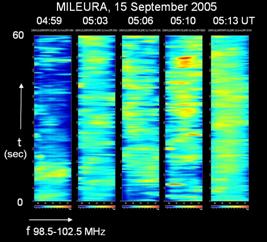Solar Burst Imaging
By its design, the MWA will provide excellent imaging capabilities that can be applied to form images of thermal and non-thermal solar emission with the high time and frequency resolution needed to perform diagnostics on plasma motion, shock formation, and particle acceleration. The MWA will thus be used to take snapshots of the Sun at a standard cadence for a long term archive of coronal morphology, and will be triggered at high resolution to follow transient events such as CMEs. Particular transient phenomena of interest will be Type II and Type III radio bursts caused by accelerated electrons associated with shock waves and magnetic reconnection.
Emphasis on the MWA observations will be placed on Type II bursts which have been associated with fast CMEs and shocks. Their imaging and precise location would serve to monitor the evolution of CMEs using the IPS and FR techniques which were noted above, thus providing a compelling a near-complete tracking of these important space weather phenomena.
 It is expected that the 32-tile system which will be the first phase of MWA construction, will be capable of important measurements of Type III bursts with fine frequency (~10 kHz) and time (~50 msec) resolution. The figure (D. Oberoi) Figure illustrates observations of such bursts made with an interferometer centered at 100 MHz consisting of only three tiles during prototype tests at Mileura in Western Australia in 2005. Burst emission with fine frequency and time resolution is observed in some of the 1-second snapshot images.
It is expected that the 32-tile system which will be the first phase of MWA construction, will be capable of important measurements of Type III bursts with fine frequency (~10 kHz) and time (~50 msec) resolution. The figure (D. Oberoi) Figure illustrates observations of such bursts made with an interferometer centered at 100 MHz consisting of only three tiles during prototype tests at Mileura in Western Australia in 2005. Burst emission with fine frequency and time resolution is observed in some of the 1-second snapshot images.
The MWA time resolution will be decreased when the full 512 tile system is deployed due to the large data volume that must be handled. A cadence of a few seconds is then expected but will be sufficient to characterize the relatively slower drift rate of Type II bursts with frequency (~-0.2 MHz/s) and lasting many minutes within the observing frequency range of the MWA. The need to localize the bursts with as fine an angular resolution as possible (~2 arcmin) has driven the deployment of 16 tiles outside the core region extending the array baselines to 3 km.
References
Salah, J. E., C. J. Lonsdale, D. Oberoi, R. J. Cappallo, J. C. Kasper, "Space weather capabilities of low-frequency radio arrays", Proc. SPIE on Solar Physics and Space Weather Instrumentation, 5901, 59010G 1-10, doi:10.1117/12.613448, 2005.

